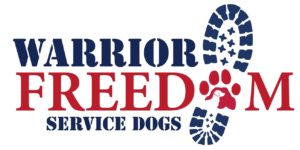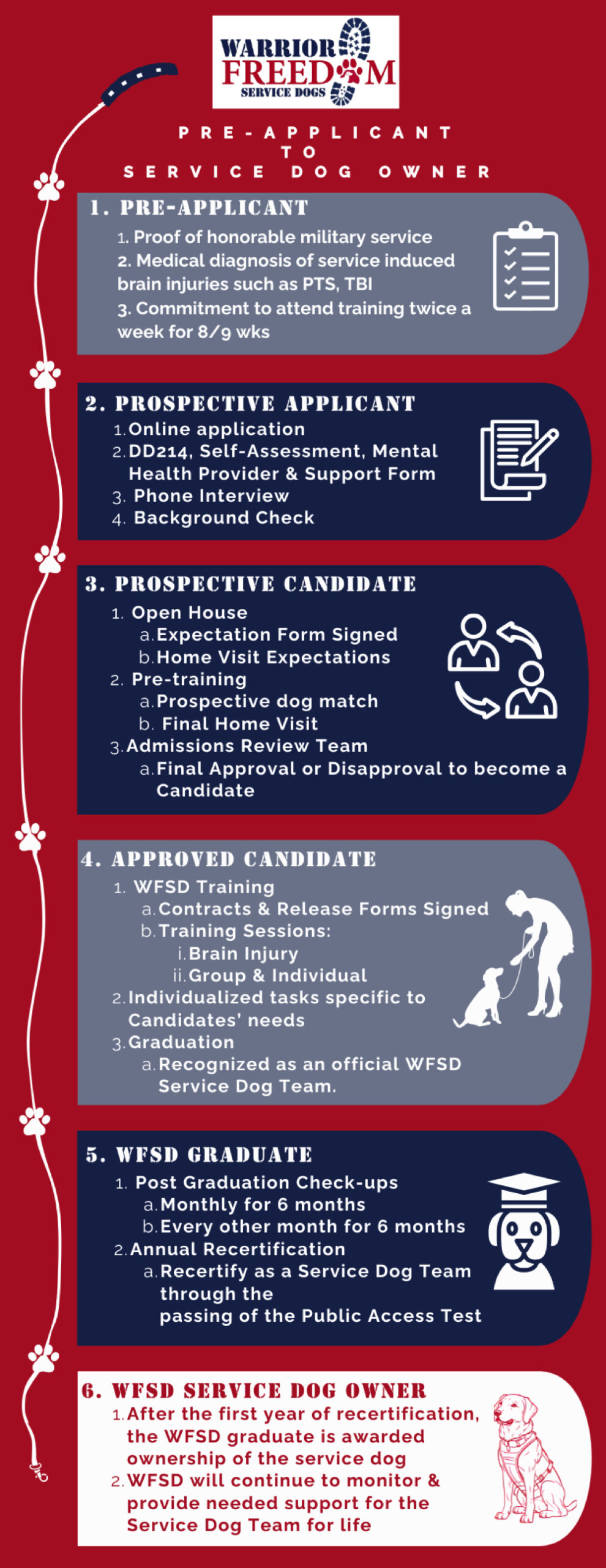More than a service animal
Our program is designed to do more than supply a service animal to a disabled Veteran. We help our Veterans reconnect to the purpose-filled life they deserve; one of doing more than they thought possible. One of a restored brotherhood. One of becoming a better brother or sister, son or daughter, father or mother, friend, and contributor to society.
We strive to give this gift of life and re-connection to the most deserving of all humans in our society: the American soldier. Our focus is on the Veterans who have returned home with service induced, deep physical, mental, and emotional wounds that make reconnecting to society a significant struggle. Our goal for each Veteran who enters our program is to become successful with their new canine life partner.
The process below is under constant evaluation to ensure the best program for our nation’s heroes.
Application
Combat veterans with Brain Injuries, such as PTSD or TBI, may apply to participate in our program.
WFSD APPLICATION STAGES
Stage 1 Qualification Screening
Stage 2 Application Process
- Step 1 Online application
- Step 2 Paperwork – (DD214, Verification of PTSD, Self-Assessment)
- Step 3 Phone Interview
- Step 4 Background Check
Stage 3 Monthly Open House
- Expectation Form Signed
- Home Visit Expectations
Stage 4 Admissions Review Team
- Final Approval or Disapproval to become a Candidate
Stage 5 Pre-training w/K9 Candidates & Final Home Visit
Stage 6 Candidate/Dog Training
- 8 weeks in duration
- Twice a week: once in a group and once in individual training sessions
- Work on individualized tasks specific to Candidates needs
Stage 7 Graduation
- Candidates & dogs are recognized as an official service dog team.
Stage 8 Post Graduate Check-ups
- Graduates meet once a month for 6 months then once every other month for 6 months with Head Trainer to refresh service dog team skills.
Stage 9 – Annual Recertification
- Graduates must recertify as a service dog team yearly through the passing of the PAT
Stage 10 – Ownership Transfer
- After the first year of recertification, the graduate is awarded ownership of their service dog
Admission
Veterans with service induced brain injuries, such as Post Traumatic Stress or TBI may apply to participate in our program.
Warrior Freedom has a multi-stage application process. Stage 1 we ensure the Veteran meets all requirements through an online Application Process. Here you will fill out an online application, receive a link to all the necessary documentation to support your qualifications for our program, complete a phone interview, and a background check.
Once we receive a complete application, background check results, DD214, letter from your provider or WFSD Medical Provider form, and self assessment we contact the applicant to schedule a phone interview.
After completion of a phone interview, the Veteran is invited to Stage 2 – Open House, where they will complete an expectations form and learn about the home visit. Next the Veteran is moved to Stage 3 – Pre-training w/K9 Candidates & Final Home Visit Here the Veteran will engage with our trainers and dogs and we will conduct a final home visit to ensure the home is safe to house a service dog.
Training
After the Home Visit – the entire application process is presented to the Admissions Review Team where they will either approve or disapprove the Veteran to become a WFSD Candidate. Once approved, the Veteran is moved to Stage 6 – Candidate/Dog Training. This is where the Veterans, animals, and Warrior Freedom staff meet one evening each week as a team to train and engage as a group. In addition, our Veterans meet privately with a Certified Professional Dog Trainer (CPDT-KA, ABCSDT) for individualized training once a week. Therefore, each Veteran is engaging with Warrior Freedom staff, trainers. and dogs twice a week during our 8 week training program where they will work with our trainers and dogs to train the dogs to perform at least three specific tasks to mitigate their PTS symptoms. Positive training techniques are utilized to build the relationships between Veterans and dogs. For this reason, we take extreme consideration when determining our training methods and which animals are ready for this critical task.
Some of the tasks the dogs are trained to perform are:
- Help act as a barrier when in crowds
Calm the handler using deep pressure therapy
Retrieve medications
Provide a sense of security that someone else is watching out for them
- Interrupt destructive behaviors
Awaken a Veteran from nightmares
Guide their handler home during a dissociative episode
Provide overall awareness to surroundings, putting the Veteran at ease and relieving them of the need to stay hyper-vigilant
We believe in training the Veteran to train the dog. This provides a deeper connection between each Veteran and dog, as well as the entire group. This period equips them with the skills to continue training while reconnecting them with the society they defended.
Training
After the Home Visit – the entire application process is presented to the Admissions Review Team where they will either approve or disapprove the Veteran to become a WFSD Candidate. Once approved, the Veteran is moved to Stage 6 – Candidate/Dog Training. This is where the Veterans, animals, and Warrior Freedom staff meet one evening each week as a team to train and engage as a group. In addition, our veterans meet privately with a Certified Professional Dog Trainer – Knowledge Assessment (CPDT-KA) for individualized training once a week. Therefore, each veteran is engaging with Warrior Freedom staff, trainers. and dogs twice a week during our 8 week training program where they will work with our trainers and dogs to train the dogs to perform at least three specific tasks to mitigate their PTSD symptoms. Positive training techniques are utilized to build the relationships between veterans and dogs. For this reason, we take extreme consideration when determining our training methods and which animals are ready for this critical task.
Some of the tasks the dogs are trained to perform are:
- Help act as a barrier when in crowds
Calm the handler using deep pressure therapy
Retrieve medications
Provide a sense of security that someone else is watching out for them
- Interrupt destructive behaviors
Awaken a veteran from nightmares
Guide their handler home during a dissociative episode
Provide overall awareness to surroundings, putting the veteran at ease and relieving them of the need to stay hyper-vigilant
We believe in training the veteran to train the dog. This provides a deeper connection between each veteran and dog, as well as the entire group. This period equips them with the skills to continue training while reconnecting them with the society they defended.
Graduation
At this point, the teams have successfully passed the following requirements: Canine Good Citizen (CGC), CGC Advanced, CGC Urban, Public Access Test, and three to five personal, specific tasks to mitigate PTS. Therefore, Warrior Freedom now recognizes them as a Service Dog team and provides each team with a service dog vest and identification card. Veterans are now equipped with the skills to reconnect with society in a new way with a best friend by their side.
After Graduation
We encourage our Veterans to stay involved in the program as we minister to the needs of a new group of Veterans. We often hear this is among the Veterans’ favorite portions of the program. We deeply believe true healing begins once we can focus on the needs of others.
In addition, we require all graduates to return once per year to retest each dog. This ensures the dog is properly serving the needs of each veteran and continues to meet the requirements of a Warrior Freedom Service Dog while creating another opportunity to offer our ongoing support for reconnection to society.


